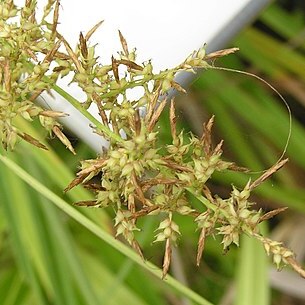Rhizome short or shortly creeping, stout, woody. Stems tufted, stout, trigonous, smooth, up to 200 cm by 2-5 mm, surrounded below the leaves by bladeless, dark reddish to blackish sheaths and their fibrous remains. Leaves (sub)coriaceous, mostly basal but 1-3 higher on the stem, much exceeding to shorter than the stems, linear, long-attenuate, flat or with revolute margins, scabrid on the margins and the nerves, (3-)5-14 mm wide. Inflorescence a slender, usually much elongated, interrupted, decompound, ferrugineous or stramineous panicle up to 70 cm long; secondary panicles 3-12, at 3-8 nodes, all or the middle ones binate at the nodes or all single, erect or suberect, oblong-linear or (broadly) oblong-lanceolate or ovoid-subpyramidal, loose to dense, 5-10 cm long, the upper approximate, the lower distant on unequal scabrid or smooth peduncles; rachis scabrid-hispid or hispidulous on the angles. Lower bracts folia-ceous, equalling or exceeding the inflorescence, long-sheathing, upper much reduced; bracteoles excurrent in a slender, ciliolate-scabrid, often recurved awn. Spikelets (very) numerous, androgynous, obliquely patent or divaricate, 4-8 (-10) mm long, ovoid to oblong, the 3 part as long as or somewhat longer than the $ part. Glumes broadly ovate, ovate or ovate-lanceolate, acute to very obtuse, membranous, (sub)translu-cent, glabrous or sparsely hispidulous, with reddish brown to dark brown streaks, 174-3 mm long, several-nerved, the midnerve of the lower ones acute or excurrent in a smooth or hispidulous, up to 1 mm long awn. Utricles distinctly or obtusely trigonous, not inflated or subinflated, (broadly) ellipsoid to ovoid, membranous or subcoriaceous, patulous or patent, straight or slightly recurved, often finally recurved, more or less distinctly several-(spongy-)nerved, glabrous or sparsely hispidulous, (sub)abruptly beaked, stramineous or brown with reddish brown streaks and spots, 2-4 by 4/5-1(-1.5) mm; beak slender, smooth or scabrid on the margins, (¾-)1-1.5 mm long, with oblique but soon bidenticulate to bifid mouth. Nut distinctly trigonous, with prominent angles and flat or concave sides, (ovoid-)ellipsoid, not or scarcely beaked, scarcely stipitate, stramineous to brown or blackish, by ¾-1 mm. Style-base not or slightly thickened. Stigmas 3.
More
Rhizome thick, woody, with stolons. Culms tufted, 40-90 × 0.3-0.5 cm, trigonous, smooth. Leaves basal and cauline, longer than culms, flat, 4-13 mm wide, scabrid abaxially, glabrous adaxially; persistent sheaths dark brown, fibriform. Involucral bracts leafy, longer than inflorescence branches, long sheathed. Panicle compound; inflorescence branches usually single, rarely binate, ovate-triangular, 4-15 × 3-6 cm; peduncles of inflorescence branches rigid, bluntly trigonous, lowest one 10-18 cm, upper ones gradually shorter, smooth; inflorescence axes trigonous, hairy; bractlets glumelike, ca. 1.5 mm, hairy abaxially. Spikes numerous, bisexual, androgynous, arising from several veined, abaxially hairy cladoprophylls, patent horizontally, 5-12 mm; male part of spike nearly as long as female part; male glumes pale brownish white with dense brown spots and short lines, lanceolate, ca. 2.5 mm, membranous, apex acuminate, mucronate; female glumes ovate, ca. 2 mm, membranous, 3-veined, apex obtuse, shortly awned. Utricles pale brownish white with brown spots and short lines, longer than glumes, elliptic, trigonous, inflated, 3-3.2 mm, smooth or upper part loosely hairy, with several raised veins, subsessile, apex attenuate into beak of medium length, beak ca. 1/3 length of utricle, hairy or glabrous laterally, orifice obliquely truncate. Nutlets dark brown at maturity, ovate-elliptic, trigonous, ca. 1.5 mm; style base thickened; stigmas 3.
A sedge. These grow in clumps and have grass like leaves and solid stalks. It grows 40-90 cm high. It has a long woody rhizome or underground stem. The stem is 1.5-2.5 mm wide. It is triangle shaped and smooth. The flowering head is 20-40 cm long.

